

Custom Surface Tension and Adhesion in Houdini 17. Fluids. Simon gladman. Houdini 16 FLIP fluid R&D - Surface tension with adhesion. Liquid Spider Effect. FLIP FLuid Morph With Velocity Wrap. [Houdini] Fill A Font With Fluid. FLIP smorganic/sheeter effect? - Page 4. » VIDEOS. No Comments.

ティーはいかがですか♪: 【Houdini】FLIPのageについてメモ. さて、前回はコンストレイントをざっと説明しましたが、実際のワークフローには全く触れませんでしたので、続編(え?)

として僕なりの使い方を紹介していこうと思います。 シーンファイルはまだの方はこちらからダウンロードしてください。 その名は==コンストレイント コンストレイントは線を引くだけの話でしたが、沢山のピースの線を手作りで一本一本引くなんて面倒くさい、もうやめた! そんな君にぴったりのがConnect Adjacent Pieces! 通常voronoiでフラグメント際自動的に各ピースに違うnameアトリビュートがつけられて、そしてscatterでnameを引き継ぐままポ イントを作成すればC.A.P.が使えます。 二番目の Adjacent Pieces from Surface Pointsの場合、scatterがすでにノードの中に組み込まれてるから自分でscatterしたらかえてエラーになります(サーフェスがなくなるため)。 さてさて、線の位置が変わることがコンストレイントにどんな影響を与えるかは動画でご確認を コンストレイントのタイプがGlueのような完全にくっ付けるタイプだと問題はないんですが、HardやSpringなどは掴む力が不完全なためフレーム毎にレズる、そして次のフレームでレズった分を戻ぞうとする。
以上の理由でGlueを使用前提でない場合はAdjacent Pieces from Pointsがお勧め。 ではここでシーンファイルに戻ります。 今回は木の枝という設定上曲がりの表現が大事です、なので回転に気を付けないといけません。 ピース同士以外にも地面とのコンストレイントを作らないと木が簡単に倒れてしまうので、地面に近いピースだけを残して別組のコンストレイントを作成します。 Let's dive to DOP! コンストレイントを適用するにはConstraint Network dopにRBDオブジェクトと使用したいConstraint Relationship dopを接続、使用可能のは:1.Glue、2.Hard、3.Spring、 そして4.ConeTwist四つのタイプ。 ところですが、Relationship dopにRest Length(Glueにはない)というパラメータが気になりません? 枝がボールにぶつかれるところの反応に注目してください。 FLIPでパーティクルのAgeを使って消しこみ « Houdini Newbie. Flow map from fluid velocity for game application. Hello everyone, I've seen a couple of post about this but not exactly what I'm looking for.
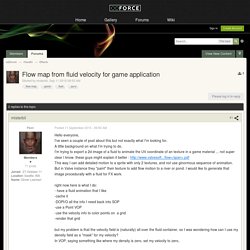
A little background on what I'm trying to do. I'm trying to export a 2d image of a fluid to animate the UV coordinate of an texture in a game material ... not super clear I know, these guys might explain it better : This way I can add detailed motion to a sprite with only 2 textures, and not use ginormous sequence of animation. But in Valve instance they "paint" their texture to add flow motion to a river or pond. サルにもわかる Houdini: make objects float. Stiky Flip Fluid.
1) i think you shouldn't use pop solver if you don't use something unique to pops. houdini copies geometry data to particle primitive, process it and then copies back - it's time. and you don't need sdf and vel from sops - you already have collision field (sdf representation of the collision objects), collisionvel field - velocity of the collision objects (set velocity type to Point). add Geometry VOP DOP (something like vop sop + volume vop sop) and sample collision field for every particle - if you closer to 0 than some threshold then sample collision vel and mix (depending on the distance to 0 levelset of the collisionvel field) or just replace v attrib of that particle.
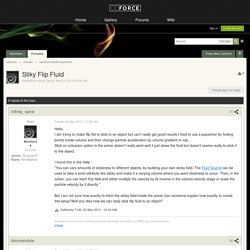
BUT. this won't give you 100% glued particles because there are some other forces, project stage of vel field and some cheats (like moving particles outside of collision objects).. this will change calculated velocities. not in front of the houdini so only bunch of text) but 1) is working 100%) Elastic effect on flip fluids on H12. That setup looks good for strain.
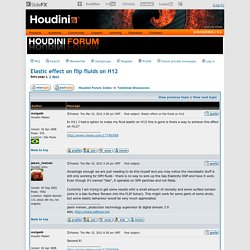
The only big thing missing is the strain isn't being rotated by the velocity field. So if you have a blob that is stretched in X, then rotated 90 degrees, it will still try to restore along the X axis. Gas Velocity Stretch is supposed to fix this, but it is a pretty subtle thing. The Power of the Ocean. TimeBlendは併用されてますか? Rnd_textureflow_pt1. In our latest feature movie I have developed a lot of procedural animated water surfaces.

Starting from small puddles to huge ocean surfaces - all this stuff was created using procedural custom noises, including Houdini Ocean Toolkit and 2d ripple solver. For a few close-up shots I used FLIP simulations sewed with animated plates. To enhance spatial details I used texture displacement projected with a simple planar projection. So next I faced the task of creating large scale water simulation. The Wave - gimpVille VFX breakdown. Microsolvers and FLIP fluids. Depends.
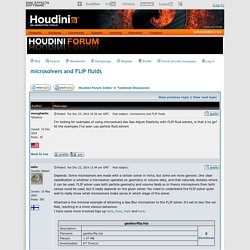
Some microsolvers are made with a certain solver in mind, but some are more general. One clear classification is whether a microsolver operates on geometry or volume data, and that naturally dictates where it can be used. FLIP Fluid - Mantra Velocity Mesh Pass - Page 2 - General Houdini Questions - od. Mikkelm2, on 27 Jan 2015 - 2:08 PM, said: Where in the shader do you add a parameter to call the cooked velocity?

The terminology here can be a bit tricky; v is an attribute on the geometry. The shader needs to bind that attribute to an input variable. This is nowadays done with a Bind VOP, but Parameter VOP performs the needed binding as well. For creating an export variable, usually a Bind Export VOP is used. Marty took advantage of this, and with a single Parameter VOP managed to take care of both import and export of the variable.
The extra image plane setup on the Mantra ROP can be used to pick up a variable that a shader exports, and put that value on an extra image plane. Apologies if I am unnecessarily verbose and you already grokked all this, but I wanted to be extra clear here. Static RBD vs Source Volume, Preferred method for Flip Collision? R&D: [Houdini] SDF based collision using custom VOP. VDB for collisions. The Particle collision method doesn't work with SourceVolume collisions (which I'm afraid probably isn't documented.)

That method uses the DOPs particle/SDF collision detection, which is very accurate and fairly fast, but it only works with DOPs collisions, i.e. when the collision is represented by an actual DOP Object that has its own collision representation; it's not using the collision field at all. With SourceVolume you're directly manipulating the collision field, so there's no DOP object representing the collision. So you have to use Move Outside Collision, which you really should prefer anyway as it's faster and generally yields "smoother" collisions. However, it's not as accurate with thin or fast-moving geometry, which is why it's not the default. Note that any DOPs/particle sim like Whitewater needs an actual DOPs object for collisions, as there's no collision field in that case. I've attached the zombie_walk file that shows this setup, without the geometry unfortunately.
Stiky Flip Fluid. FLIP, VDB and Collisions. I'm getting nuts with a scene where water is flowing through some tubular/ pipe geometry.
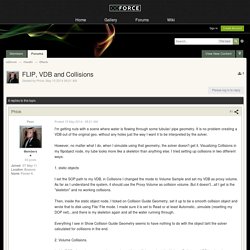
It is no problem creating a VDB out of the original geo, without any holes just the way I want it to be interpreted by the solver. However, no matter what I do, when I simulate using that geometry, the solver doesn't get it. Visualizing Collisions in my flipobject node, my tube looks more like a skeleton than anything else. I tried setting up collisions in two different ways: 1. static objects I set the SOP path to my VDB, in Collisions I changed the mode to Volume Sample and set my VDB as proxy volume. Then, inside the static object node, I ticked on Collision Guide Geometry, set it up to be a smooth collision object and wrote that to disk using File/ File mode. Everything I see in Show Collision Guide Geometry seems to have nothing to do with the object taht the solver calculated for collisions in the end.
Attach FLIP animation to animated SOP Geometry. H12 flip emitter rate? Thin Fluid Flip - Reducing PartSep makes it worse?! Danw, on 29 Mar 2014 - 04:26 AM, said: I'm not so certain about the Update Velocity method (or the Update Surface method for that matter)... I presumed similar, that it would have a major effect on the simulation, but when I've tested it, setting "None", "Advect" or "Rebuild" all seem to give an identical simulation result.
[snip good conjecturing on Update methods]Interesting information about the advection method. I'll have to do some testing to see what effect switching to HJWENO has. .: Street Flood :. Quick Gap Fill Method for thin sheets FLIP simulations. Whitewater, foam shading and rendering. Hi guys. Looks like the question never has been asked.
I'm a kind of new in da "Houd" and i'm totally amazed by possibilities. I have a decent bunch of experience years using Maya and i can't believe how big the difference is. That's said, my question is, please, how can i get a decent whitewater foam look? By default, the material applied is the default spray shader but gives me that smoke look. PIC/FLIP Simulator Meshing Pipeline. In my last post, I gave a summary of how the core of my new PIC/FLIP fluid simulator works and gave some thoughts on the process of building OpenVDB into my simulator. In this post I’ll go over the meshing and rendering pipeline I worked out for my simulator.
Two years ago, when my friend Dan Knowlton and I built our semi-Lagrangian fluid simulator, we had an immense amount of trouble with finding a good meshing and rendering solution. We used a standard marching cubes implementation to construct a mesh from the fluid levelset, but the meshes we wound up with had a lot of flickering issues. The flickering was especially apparent when the fluid had to fit inside of solid boundaries, since the liquid-solid interface wouldn’t line up properly. Code & Visuals.
FLIP smorganic/sheeter effect? 薄い液体層を保持可能な粒子ベースの流体表現. [English] 薄い液体層を保持可能な粒子ベースの流体表現 安東遼一 鶴野玲治. Ryoichi Ando. [Japanese] Summary My objective is to establish numerical tools for beautiful physics simulations. More specifically, I have engaged myself for the past five years in developing new numerical simulation techniques for detailed fluids in the context of computer graphics. My strong passion for design and aesthetics drives me to work on computer graphics. Making of a Houdini FLIP Explosion. Mixing / advecting Cd in FLIP sim with multiple objects. Hello all I have a problem with a FLIP sim I'm working on. I'm trying to set something up where randomly coloured painballs get thrown at a wall.
I have a custom stick field to stick the paint where there is some text on the wall - that's working ok so far. Openvdb for Mtoa. Foam and spray. Borisb2, on 26 Sept 2014 - 12:47 AM, said: but you're saying it would be ok to cache out main sim with substepping of 2 (but as $F4.bgeo), and still use ww-setup with substepping of 1? Thats what I'm doing at the moment, and for foam and bubbles it looks correct .. just the spray overshoots.. So... turns out the spray overshoot is a bug, and it's been in H13 for a long time. Thank you for complaining loudly enough and providing a good enough test case to force a thorough investigation Just a bit of background, the Whitewater Solver first showed up in H12.5 and was the only thing to use the fledgling POPs in DOPs framework.
The problem has been there since H13's release; your case just shows it really well because 1) you have fluid with a high speed leading edge, 2) you've got Timescale set to 0.8, which means time is slightly slowed down in the FLIP and WW solver. Is there a way to constrain particles to a surface while they are movi - Page 2 - General Houdini Questions - od.
Houdini Flip Simulation – Hallway Flood Scene Tutorial. Free Tutorial Series by Rajiv Sharma, Technical Director In this Tutorial Series I will cover following: Part01 – Export scene from Maya to Houdini Part02 – understand alembic scene and prepare for simulations Part03 – create flip simulation Part04 – create foam, spray and bubbles Part05 – export simulations in bGEO Part06 – meshing of particles with VDB tools Part07 – Photo realistic Texturing and Shading of Flip Scene Part08 – Physically accurate Lighting setup Part09 – Render passes from Houdini Part10 – Compositing in Nuke You can subscribe to get updates of all Free Visual Effects Tutorials. Introduction Video Part01 – Export scene from Maya to Houdini Part02 – Alembic Scene and Prepare for Texturing, Simulations, Animation and Rendering.
Valerio Di Napoli: Houdini - UV on particle fluids. Last week I did some research about the techniques to add UVs on particle fluid. Budsberg-etal_DigiPro13.pdf.
Motion blur VDB volume. Generate millions particles at rendertime. Two ways: In SOPs you can use the Point Replicate SOP to take your tens or hundred of thousands of particles and turn it in to hundreds of thousands or tens of millions. It's surprising how efficient this SOP is and it is all visible in the viewport. Volume Rendering Particles as Liquid Volume - Shaders. Hey,everyone, 3D INK. Krakatoa shader. Very awesome. 波の大事な性質 [物理のかぎしっぽ] Getting more volume in flip. Sorry for delay, was busy breaking things at work. I am able to tweak further Jeff's scene to get more details in sim. But let me first answer your questions. 1.At what scale should i sim with respect to world scale …. More detail to small scale FLIP. .: Houdini 13 Flip wedges :. .: Houdini 13 Flip wedges :.
FX-TD.com. Velocity pass render from flip fluids. FLIP Fluid - Mantra Velocity Mesh Pass. How to use vorticity attribute as point color in Flip? Droplets with metaballs, whats wrong here? Getting more volume in flip. Houdini Flip VDB bubbles test. Mixing / advecting Cd in FLIP sim with multiple objects. Flip & Example. Helicopter+Dynamic FLIP Waves Test - Work in Progress. Krakatoa shader - Page 3 - General Houdini Questions - od. Mogami Houdini FLIP Solver settings RnD. Foam and spray. FLIP UVs, again.. - Side Effects Software Inc.